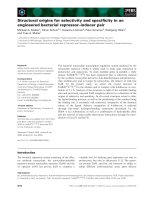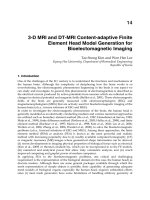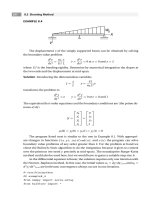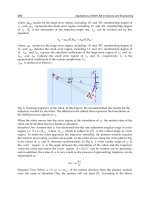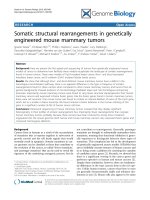Lecture Requirement engineering Chapter 8 Risks in requirements engineering
Bạn đang xem bản rút gọn của tài liệu. Xem và tải ngay bản đầy đủ của tài liệu tại đây (1.18 MB, 27 trang )
Risk
management provides a standard
approach to
Identify and document risk factors
Evaluate their potential severity
Propose strategies for mitigating them
Risk
assessment: is the process of examining a
project to identify areas of potential risk.
Risk identification: makes lists of common risk
factors for software projects
Risk analysis: Examine the potential consequences
of specific risks to your project.
Risk prioritization: focus on the most severe risks
by assessing the potential risk exposure from each.
Risk
avoidance :
You can avoid risks by not undertaking
certain
projects, by relying on proven rather than cuttingedge technologies, or by excluding features that
will be especially difficult to implement correctly.
Software development is intrinsically risky, though,
so avoiding risk also means losing an opportunity.
Risk
control: manage the top-priority risks
Risk management planning: produce
a plan for
dealing with each risk including mitigation
approaches, contingency plans, owners, and
timelines
Risk resolution involves executing the plans for
mitigating each risk.
Risk monitoring: track your progress toward
resolving each risk item through
Risks
factors are organized by the requirements
engineering sub-disciplines:
Elicitation
Analysis
Specification
Verification
Management
Techniques are suggested that can reduce:
Either the probability of the risk materializing into a
problems
Or the Impact on the projects if it does.
Product
Vision and scope:
Team members don’t have a clear, shared
understanding of what the product is supposed to
be or do.
Early in the project write a vision and scope
document that contains your business
requirements and use it to guide decisions about
new or modified requirements.
Time
spent on requirements development
Tight projects schedules
often pressure managers
into glossing over the requirements.
A rough guideline is :
To spend about 15 per cent of your project effort
on requirements development activities.
Keep records of how much efforts you actually
spend on requirements development you can
judge whether it is sufficient and improve your
planning for future projects.
Completeness
and correctness of
requirements specification
Apply the use case technique to elicit
requirements by focusing on user tasks. This
ensure that you will capture real customer needs.
Devise specific usage scenarios.
Write test cases from requirements
Create prototypes to make the requirements more
tangible for users and to elicit specific feedback
from them.
Requirements
for highly innovative products:
Emphasize marked research, build prototypes,
Use customer focus groups to obtain early and
frequent feedback about your innovative product
visions.
Defining
Non functional requirements
Natural emphasis on product
functionality and
easy neglect of non functional ones.
Query customers about quality characteristics:
performance, reliability, usability….
Document these NF requirements and their
acceptance criteria in the SRS document.
Customer
agreement on product
requirements:
Determine who
the primary customers are.
Make sure you have adequate customer
representation and involvement
Make sure you are relying on the right people for
decision making authority on requirements.
Unstated
requirements:
Customers might hold implicit expectations that
are not communicated or documented.
Try to identify and record any assumptions the
customers might be taking.
Use open ended questions to encourage customers
to share more of their thoughts, ideas and
concerns than you might otherwise hear.
Existing
product used as the requirement
baseline:
Developers are sometimes told to use the existing
product as their source for requirements (fix
specific bugs, add new features).
Document the requirements that you discover
through reverse engineering, and have customers
review those requirements to ensure that they are
correct and still relevant
Requirement
prioritization
Ensure that every requirement, feature or use case
is prioritized and allocated to a specific product
release or implementation stage.
Evaluate the priority of every new requirement
against the existing body of work remaining to be
done so you can make clever trade-off decisions.
Technical
difficult features:
Evaluate the feasibility of each requirement to
identify those that might take longer to implement
than planned.
Use your project status tracking to watch for
requirements that are falling behind their
implementation schedule.
Take corrective action as early as possible,
Unfamiliar
technologies, methods, tools, or
hardware
Don’t underestimate the learning curve of getting
up to speed with new techniques that are needed
to satisfy certain requirements
Identify those high risks requirements early
Allow sufficient time for false starts, learning,
experimentation and prototyping.
Requirement
Understanding:
Different understandings
of the requirements by
developers and users may lead to expectation gaps.
Formal inspections of requirements documents by
teams including developers, testers, and customers
can mitigate the risk.
Trained and experimented requirements analysts will
ask the right questions and write better specification.
Models and prototypes that represent the
requirements from multiples perspectives will reveal
fuzzy and ambiguous requirements.
Time
pressure to proceed despite TBDs
Good idea to mark areas of the SRS document that
need further work with ‘to be determined’ (TBD).
But it is risky to proceed with the construction if
these TBDs have not been resolved.
Record the name of the individual responsible for
resolving each TBD, how it will resolved, and the
target date for resolution.
Ambiguous
terminology
Create a glossary and data dictionary to define all
business and technical terms that might be
interpreted differently by different readers.
Especially define terms that have both common
and technical or domain-specific meanings
Specific reviews can help participants reach a
common understanding of key terms and concepts.
Unverified
requirements
Inspecting a lengthy
SRS, writing test cases very
early in the development process may appears
fastidious.
However if you verify the quality and correctness
of the requirements before construction begins,
through inspection, requirements-based test
planning and prototyping you can greatly reduce
expensive rework later in the project.
Unverified
requirements
Include time and resources for these quality
activities in he project plan.
Gain commitments from your customer
representatives to participate in requirements
inspections.
Perform incremental, informal reviews prior to
formal inspections to find problems as early and
cheaper as possible.
Inspection
proficiency:
Serious defects might be missed in case inspectors
do not know to properly inspect requirements
documents, and to contribute to effective
inspections.
Train all team members who will participate in
inspections of requirement documents.
Invite an experienced inspector from your
organization or outside consultant to observe and
moderate your early inspections to help make
them effective.
Requirement change process:
Risks from the way changes to requirements are
managed include not having a defined change process,
using an ineffective change mechanism, and permitting
changes to be made without following the process.
You will need to develop a culture and discipline of
change management at all levels.
A requirements change process that includes impact
analysis of proposed changes, a change control board
to make decisions, and a tool to support the defined
procedure is an important starting point.
